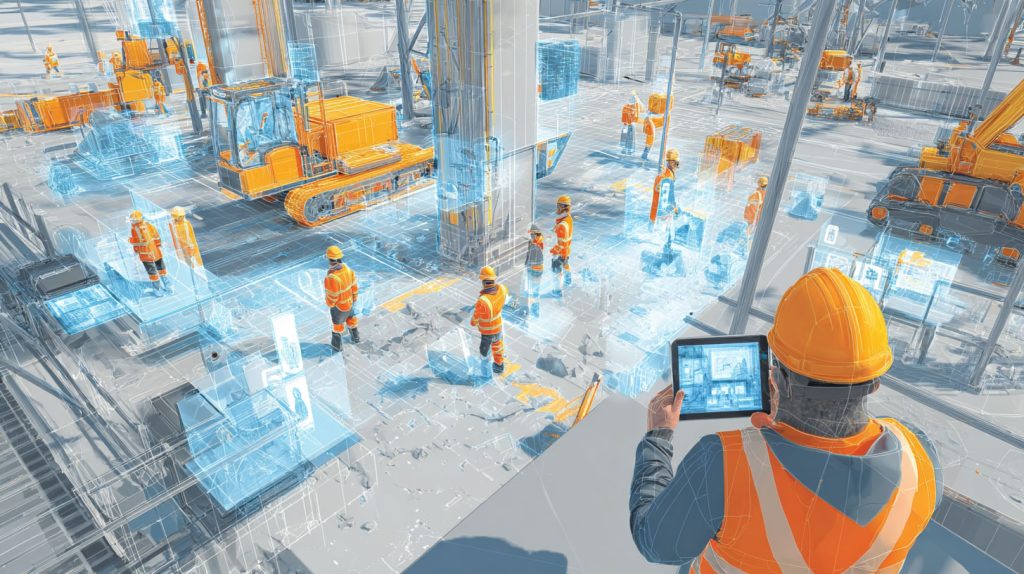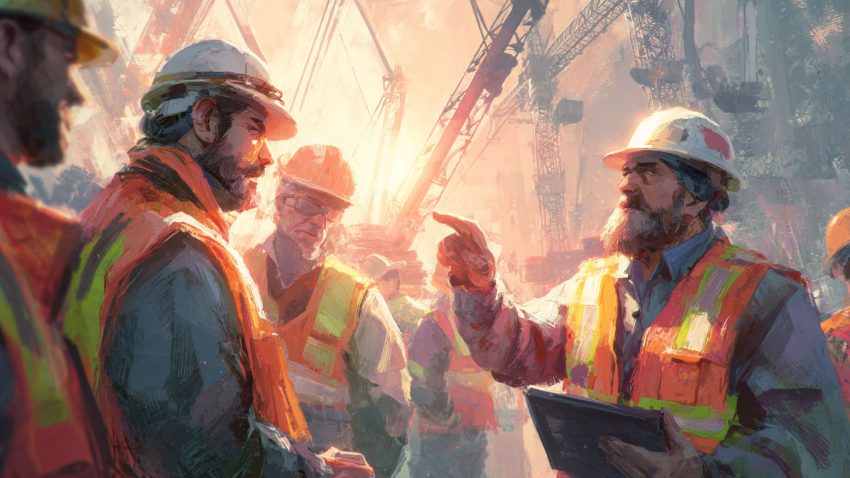Top Reasons to Switch From Paper Pre-Task Plans to a Digital Construction Safety Platform
Table of Contents:

Every superintendent knows that safety starts with preparation—and Pre-Task Plans (PTPs) are the first step in keeping crews aware, compliant, and productive. But for too long, PTPs have lived on clipboards and in binders, slowing down communication, burying critical information, and creating unnecessary administrative work. In a fast-paced construction environment, paper processes simply can’t keep up.
That’s why leading contractors are making the switch to digital construction safety platforms. These tools replace outdated paper forms with mobile, cloud-based systems that let crews complete PTPs in the field and instantly share them with supervisors and safety teams. No more missing pages, illegible handwriting, or delays waiting for approvals—just real-time visibility, accuracy, and accountability.
Digital safety platforms also unlock new advantages that paper never could. They store every PTP securely online, track completion status automatically, and provide analytics that reveal trends in jobsite safety performance. AI can even help identify recurring hazards or flag incomplete plans before work begins.
In this article, we’ll cover the top reasons to switch from paper PTPs to a digital safety platform, what features matter most, and how platforms like StruxHub make the transition easy. You’ll see how digitizing safety planning not only protects workers but also improves coordination, saves time, and strengthens overall project efficiency.
Reason 1: Paper Slows Safety Communication—Digital Keeps It Instant
Paper forms may have worked decades ago, but today’s jobsites move too fast for slow safety communication. With hundreds of workers, multiple trades, and overlapping shifts, superintendents need real-time visibility into who’s reviewed safety plans and whether hazard controls are in place.
Digital safety platforms eliminate this lag. Crews can complete and submit PTPs from tablets or smartphones, and superintendents receive instant notifications for approval. Updates, sign-offs, and revisions sync automatically across the project—no courier trips to the trailer or stacks of forms to review manually.
When safety plans are accessible in real time, field awareness skyrockets. Crews can reference them on demand, supervisors can verify compliance instantly, and management can see progress without delay. The result is faster coordination, fewer miscommunications, and safer operations.
Top Benefits
- Enables instant safety communication across crews and management.
- Reduces delays caused by missing or incomplete paper forms.
- Keeps safety documentation updated and visible in real time.
Best Practices
- Require digital PTP submission before work starts each shift.
- Use automatic alerts to flag overdue or unsigned safety plans.
- Train foremen to review and approve plans using mobile devices.
Q&A Mini Section
Q: How do digital PTPs improve communication?
A: They deliver updates instantly to all team members, ensuring everyone has the latest safety information.
Q: What happens when PTPs are still on paper?
A: Information gets delayed, lost, or misinterpreted, creating unnecessary risk and inefficiency.
Q: Can digital PTPs replace verbal safety briefings?
A: No—they complement them by reinforcing discussions with accurate, shareable records.
Real-time communication is the foundation of safe, efficient jobsites—and digital PTPs make it effortless.

Reason 2: Paper Creates Risk—Digital Provides Accountability
Paper-based safety documentation leaves too much to chance. Missing signatures, unclear handwriting, and misplaced forms can all lead to compliance gaps—and in the event of an accident, missing documentation can become a legal and financial liability.
Digital safety platforms eliminate that uncertainty. Every Pre-Task Plan is time-stamped, digitally signed, and stored securely in the cloud. Superintendents can verify that each crew member reviewed the plan before starting work, and auditors can access complete records instantly if needed.
This transparency builds accountability at every level. Crews know their participation is tracked, foremen can’t skip steps, and managers can quickly confirm that safety planning has been completed for each shift or work zone.
Most importantly, digital systems protect against human error. Automatic reminders ensure PTPs are updated when conditions change, and reports are generated automatically to track compliance over time.
Top Benefits
- Ensures verifiable proof of compliance and crew acknowledgment.
- Reduces legal and administrative risks caused by incomplete records.
- Improves accountability and safety ownership among crews.
Best Practices
- Require digital sign-offs for every PTP submission.
- Store all safety data in secure, cloud-based repositories.
- Run weekly compliance reports to verify completion rates.
Q&A Mini Section
Q: Why is accountability so important in safety planning?
A: It ensures every worker takes responsibility for understanding and following hazard controls.
Q: What if crews forget to sign PTPs?
A: Digital systems send automated reminders, preventing missed sign-offs.
Q: Can digital records be used for audits or insurance claims?
A: Yes—they provide legally valid proof of compliance, improving transparency and risk protection.
By replacing paper with digital accountability, safety becomes measurable, trackable, and enforceable.

Reason 3: Paper Gets Lost—Digital Keeps Safety Data Forever
A common frustration for superintendents is losing critical safety documents. Paper PTPs often end up wrinkled, incomplete, or misplaced after a long day in the field. When inspectors or owners request documentation, searching through file boxes wastes valuable time.
With digital platforms, those days are gone. Every Pre-Task Plan is stored in a centralized, cloud-based system that can be accessed instantly from any device. Files are organized by project, date, trade, and task—making it easy to retrieve past records for audits, closeouts, or safety reviews.
Digital PTPs also improve data retention. Instead of archiving paper files that degrade or disappear, projects maintain permanent, searchable digital records. This creates a reliable history of safety performance that can be analyzed to identify long-term improvements.
Top Benefits
- Prevents loss or damage of important safety documentation.
- Simplifies audits and project closeouts with searchable digital archives.
- Preserves long-term data for safety analysis and improvement.
Best Practices
- Store all PTPs in one centralized platform for consistency.
- Tag records by project phase or trade for easier retrieval.
- Use reporting tools to extract historical safety data for analysis.
Q&A Mini Section
Q: Why is digital storage more reliable than paper?
A: Cloud-based storage keeps safety records secure, backed up, and accessible indefinitely.
Q: How long should PTPs be kept on file?
A: Many companies retain digital PTPs for 5–10 years to meet compliance and audit requirements.
Q: Can older paper PTPs be converted to digital format?
A: Yes—scanning and uploading legacy documents ensures all data is centralized moving forward.
Digital storage transforms safety documentation from a liability into an asset—organized, permanent, and always accessible.

StruxHub
Experience the power of StruxHub today and witness firsthand how it can revolutionize your construction operations.
Reason 4: Paper Is Reactive—Digital Predicts and Prevents Hazards
Paper-based safety planning only captures what’s already been identified, but digital platforms powered by AI and analytics take safety to the next level by predicting what could go wrong. These systems analyze jobsite data—such as task types, weather conditions, and previous incidents—to anticipate high-risk activities and alert teams before accidents occur.
For superintendents, this means they can plan smarter, not just faster. Digital systems learn from historical PTPs and automatically suggest hazards, control measures, and required PPE based on similar jobs. Instead of relying solely on memory or manual checklists, crews benefit from a data-driven guide that helps them focus on the most relevant risks.
Over time, AI helps identify patterns that may not be obvious day-to-day—like which trades experience the most near-misses or what conditions trigger recurring safety issues. This insight transforms safety from a reactive process into a predictive one.
Top Benefits
- Identifies hazards before they cause incidents.
- Learns from historical data to improve future PTPs.
- Enhances training by showing recurring risk patterns.
Best Practices
- Use AI-generated hazard libraries as starting points for field discussions.
- Review predictive reports weekly to adjust safety strategies.
- Pair digital insights with superintendent field observations.
Q&A Mini Section
Q: How does AI improve jobsite safety?
A: It uses data from past projects to predict risks, helping teams focus on high-probability hazards.
Q: Does AI replace safety managers?
A: No—it enhances their decision-making with data-driven insights.
Q: How quickly can predictive systems learn?
A: They improve continuously as more project data and PTPs are logged into the system.
Digital safety planning powered by AI helps superintendents shift from reacting to problems to preventing them altogether.
Reason 5: Paper Is Stationary—Digital Moves With the Field
Construction doesn’t happen behind a desk—it happens in motion. Crews move between buildings, levels, and work zones, often in areas with little or no network connectivity. Paper PTPs can’t follow the pace of this environment. But digital safety platforms with mobile and offline capabilities can.
With digital tools, crews can access, update, and sign Pre-Task Plans directly from their mobile devices—even in remote areas or underground structures. Once connectivity returns, all data syncs automatically, ensuring records remain accurate and complete.
For superintendents, mobile accessibility means instant visibility. They can approve plans, monitor compliance, and receive alerts for any outstanding PTPs—all without leaving the field. This saves time and ensures that safety oversight keeps up with production.
Top Benefits
- Allows PTP completion and sign-off anywhere, even offline.
- Keeps superintendents connected to field safety in real time.
- Reduces downtime caused by logistical paperwork.
Best Practices
- Equip foremen with tablets or smartphones configured for PTP access.
- Sync devices daily to keep records up to date.
- Train crews to review plans and updates directly from mobile devices.
Q&A Mini Section
Q: How does mobile access improve safety compliance?
A: It makes reviewing and signing PTPs quick and easy—no excuses for missed documentation.
Q: What happens if crews lose connectivity?
A: Offline mode saves data locally and syncs it automatically once service returns.
Q: Can superintendents monitor PTPs on their phones too?
A: Absolutely—dashboards and alerts work seamlessly across mobile devices.
Mobility turns safety from a paperwork task into an active, on-the-go process that keeps up with the pace of construction.
Reason 6: Paper Costs Time—Digital Creates Efficiency
Managing hundreds of paper PTPs each week is time-consuming. Collecting, filing, reviewing, and storing them consumes hours of a superintendent’s day—and often requires administrative staff just to stay organized. Switching to digital eliminates these inefficiencies entirely.
Digital PTP platforms automate repetitive tasks like form distribution, signature collection, and archiving. Reports and summaries are generated automatically, cutting administrative labor in half. Superintendents can review multiple PTPs at once through visual dashboards rather than sifting through piles of paper.
The efficiency gains don’t stop at the office. Field crews save time too—no more waiting for approvals or walking back to the trailer to submit forms. Everything happens instantly, enabling faster starts and smoother transitions between tasks.
By freeing up valuable time, digital safety tools allow superintendents to focus on what matters most: coaching crews, managing coordination, and maintaining site progress safely.
Top Benefits
- Saves hours in paperwork and administrative labor.
- Streamlines approvals and recordkeeping for faster workflows.
- Improves jobsite efficiency through instant digital coordination.
Best Practices
- Transition gradually—start with one trade or zone before scaling up.
- Automate reporting for weekly or monthly safety metrics.
- Use analytics dashboards to track time saved and productivity gains.
Q&A Mini Section
Q: How much time can digital PTPs save?
A: Most teams report saving 2–3 hours per day between paperwork, filing, and review time.
Q: What about small teams—does digital still help?
A: Yes—less paperwork means more time for field supervision and communication.
Q: Can digital systems handle multi-project safety management?
A: Absolutely—cloud-based platforms manage data across multiple projects simultaneously.
Efficiency is one of the most overlooked benefits of digitization—but it’s also one of the most valuable for productivity and safety combined.

How StruxHub Simplifies the Transition From Paper to Digital
Switching from paper PTPs to a digital safety platform doesn’t have to be complicated. StruxHub makes the transition seamless with user-friendly features that combine mobility, automation, and data intelligence.
With StruxHub, crews can create, sign, and submit Pre-Task Plans directly from the field using smartphones or tablets. Superintendents can review, approve, and monitor compliance in real time through live dashboards. The system automatically stores every PTP in the cloud, providing an organized, searchable archive that’s accessible anytime.
StruxHub also uses AI analytics to detect recurring hazards, measure participation rates, and identify areas for improvement. Integration with scheduling, logistics, and inspection modules keeps safety fully connected to daily jobsite operations.
For contractors ready to move away from paper, StruxHub provides step-by-step onboarding, customizable templates, and built-in training resources that make adoption fast and intuitive. It’s designed for the way superintendents actually work—on the go, under pressure, and with safety always at the forefront.
Top Benefits
- Digitizes PTPs with mobile access, cloud storage, and real-time analytics.
- Simplifies adoption with customizable templates and training.
- Integrates safety data with scheduling, inspections, and logistics.
Best Practices
- Start by digitizing high-risk activities or trades first.
- Leverage StruxHub’s analytics dashboard for performance tracking.
- Conduct weekly reviews to compare safety performance pre- and post-digitization.
Q&A Mini Section
Q: How fast can teams switch to StruxHub’s digital PTPs?
A: Most contractors can be fully onboarded in under two weeks with minimal training required.
Q: Does StruxHub replace safety meetings?
A: No—it enhances them by providing digital tools that make discussions more focused and traceable.
Q: Why is StruxHub ideal for large or mission-critical projects?
A: It scales effortlessly, offering real-time safety visibility across multiple crews, trades, and sites.
StruxHub doesn’t just help you go paperless—it redefines how safety planning is managed, shared, and improved across every project.

FAQ
Why are so many contractors moving away from paper Pre-Task Plans?
Contractors are switching from paper-based Pre-Task Plans (PTPs) because construction sites have become too large, fast-paced, and complex for manual documentation to keep up. Paper forms often create bottlenecks—getting misplaced, completed inaccurately, or submitted too late to be useful. On high-risk sites, delayed or incomplete safety communication can have serious consequences.
Digital platforms solve this by allowing crews to complete, sign, and submit PTPs instantly from the field. Superintendents can review approvals, verify signatures, and monitor compliance in real time. No more waiting until the end of the day to find out a crew didn’t complete its plan or missed a critical control.
The move away from paper also improves accountability and transparency. Every digital PTP is time-stamped and stored securely in the cloud, providing a permanent, auditable record of compliance. This makes safety management faster, more reliable, and more traceable—qualities that paper simply can’t match.
For modern construction companies, going digital isn’t just a tech upgrade—it’s a cultural shift toward smarter, safer, and more proactive project management.
How do digital safety platforms improve communication and coordination?
Digital safety platforms create a single source of truth for safety communication. When crews, foremen, and superintendents are all working from paper forms, it’s easy for information to be fragmented or outdated. A digital system eliminates these gaps by syncing every update across all devices instantly.
When a Pre-Task Plan is created or updated, all relevant parties receive alerts. Crew leaders can share the plan during morning briefings, and supervisors can review sign-offs in real time. If a hazard changes mid-day—like weather conditions or site access—digital tools allow for immediate updates, ensuring no one is left in the dark.
This real-time communication strengthens collaboration between trades and improves project flow. Field teams don’t have to waste time tracking down forms or redoing paperwork, and management gains confidence knowing the entire site is operating under the latest safety information.
By connecting people through a shared digital platform, communication becomes faster, clearer, and far more reliable—key ingredients for both safety and productivity.
StruxHub
Discover how StruxHub can revolutionize your construction management. Contact us today!
Are digital safety platforms difficult or expensive to implement?
Surprisingly, no. Most modern safety platforms are designed to be simple, scalable, and cost-effective. Cloud-based systems require little to no hardware investment—just mobile devices that most crews already use. Setup is typically fast, with templates, training materials, and user guides included to ensure teams are up and running in days, not months.
The cost of digital safety tools is also offset by the savings they generate. Eliminating paper, printing, and administrative labor can save thousands of dollars annually. Add to that the reduction in downtime, rework, and compliance risks, and the ROI becomes clear.
Most importantly, the learning curve is minimal. Digital PTP systems like StruxHub are built for the field, featuring intuitive interfaces that crews can use with little training. Many companies find that once teams experience the convenience of digital tools, adoption spreads quickly.
In short, going digital isn’t complicated—it’s a straightforward way to reduce costs, boost efficiency, and make safety planning easier for everyone involved.
How do digital safety platforms support compliance and audit readiness?
Compliance and documentation are two areas where digital platforms deliver significant value. With paper systems, tracking every signature, approval, and update can be nearly impossible. During audits or incident investigations, missing or incomplete records can create major challenges.
Digital safety platforms automatically store every PTP, inspection, and sign-off in a centralized, searchable database. All data is time-stamped, organized by project or trade, and accessible instantly from any device. This not only ensures full traceability but also simplifies the process of proving compliance to clients, insurers, and regulatory agencies.
Audit readiness improves dramatically. Instead of spending hours digging through boxes of paper, teams can generate a digital report showing all completed safety plans within seconds. Automated reminders also ensure PTPs are reviewed and updated as required, keeping the entire workforce aligned with compliance standards.
By streamlining documentation and audit preparation, digital platforms turn compliance from a stressful process into a daily habit—protecting both contractors and owners.
How does StruxHub make the transition from paper to digital safety simple?
StruxHub was designed specifically to help superintendents and contractors transition smoothly from paper-based safety management to a fully digital workflow. Its mobile-friendly interface allows crews to create, review, and sign Pre-Task Plans directly in the field—no paperwork required.
StruxHub’s onboarding tools make adoption easy. Customizable templates replicate existing paper forms, so teams don’t have to start from scratch. Built-in training resources help crews get comfortable with the system quickly, and customer support ensures the rollout stays on track.
Once implemented, StruxHub automatically syncs every PTP, inspection, and sign-off to the cloud. Supervisors can view safety performance metrics in real time, track participation, and analyze trends using built-in analytics. The platform’s integration with scheduling and logistics modules ensures safety planning stays aligned with field operations.
For contractors ready to modernize, StruxHub delivers a complete digital solution—making safety smarter, simpler, and scalable for projects of any size.




